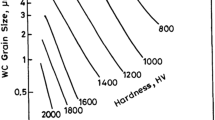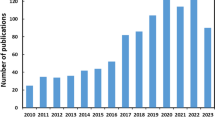Abstract
Dry machining will result in elevated temperatures at the tool surface (800–1000°C). So, coating materials that can provide protection for cutting tools at these temperatures are of great technological interests. ZrAlN coating is proposed to possess high-temperature stable structural and mechanical properties due to the addition of the alloying element. ZrAlN coatings were grown using a dc reactive magnetron sputtering. The XRD and nano indenter were employed to investigate the effects of reaction gas partial pressure and substrate bias on structural and mechanical properties, as well as high-temperature stability. The ZrAlN coating, when deposited under optimum conditions (−37 V substrate bias and 2 × 10−5 Pa N2 partial pressure), showed smooth surface with thermal stable hardness. Its internal stress was relaxed from 2.2 to 0.7 GPa after annealing. Formation of Al2O3 and ZrO2 crystalline phases should be related to thermal stability of the coatings.
Similar content being viewed by others
References
Musil J. Hard and superhard nanocomposite coatings. Surf Coat Technol, 2000, 125: 322–330
Bull S J. Modelling the hardness response of bulk materials, single and multilayer coatings. Thin Solid Films, 2001, 398–399:291–298
Tavares C J, Rebouta L, Almeida B, et al. Deposition and characterization of multilayered TiN/ZrN coatings. Thin Solid Films, 1998, 317: 124–128
Karimi A, Wang Y, Cselle T, et al. Fracture mechanisms in nanoscale layered hard thin films. Thin Solid Films, 2002, 420–421: 275–280
Wang J L, Yu Y H, Lee S C, et al. Tribological and optical properties of crystalline and amorphous alumina thin films grown by low-temperature reactive magnetron sputter-deposition. Surf Coat Technol, 2001, 146–147: 189–194
Chen Y H, Lee K W, Chiou W A, et al. Synthesis and structure of smooth, superhard TiN/SiNx multilayer coatings with an equiaxed microstructure. Surf Coat Technol, 2001, 146–147: 209–214
Li Q, Yu Y H, Bhatia C S, et al. Low-temperature magnetron sputter—eposition, hardness, and electrical resistivity of amorphous and crystalline alumina thin films. J Vac Sci Technol, 2000, A18: 2333
Blando E, Hübler R. Microhardness characterization of superlattices formed by reactive magnetron sputtering and ion beam assisted deposition. Surf Coat Technol, 2002, 158–159: 685–689
Rincón C, Romero J, Esteve J, et al. Effects of carbon incorporation in tungsten carbide films deposited by r.f. magnetron sputtering: Single layers and multilayers. Surf Coat Technol, 2003, 163–164: 386–391
Nose M, Zhou M, Honbo E, et al. Colorimetric properties of ZrN and TiN coatings prepared by DC reactive sputtering. Surf Coat Technol, 2001, 142–144: 211–217
Makino Y, Mori M, Miyake S, et al. Characterization of Zr-Al-N films synthesized by a magnetron sputtering method. Surf Coat Technol, 2005, 193(1–3):219–222
Author information
Authors and Affiliations
Rights and permissions
About this article
Cite this article
Li, D. Synthesis of ZrAlN coatings with thermal stability at high temperature. SCI CHINA SER E 49, 576–581 (2006). https://doi.org/10.1007/s11431-006-2019-9
Received:
Accepted:
Issue Date:
DOI: https://doi.org/10.1007/s11431-006-2019-9




